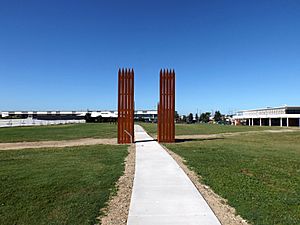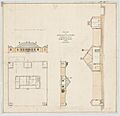Eagle Farm Women's Prison and Factory Site facts for kids
Quick facts for kids Eagle Farm Women's Prison and Factory |
|
|---|---|

Footpath through the site, 2015
|
|
| Location | 116 Lamington Avenue, Eagle Farm, City of Brisbane, Queensland, Australia |
| Design period | 1824 - 1841 (convict settlement) |
| Built | 1830 - 1839 |
| Official name: Eagle Farm Women's Prison and Factory Site, Eagle Farm Agricultural Establishment, Eagle Farm Women's Prison and Factory | |
| Type | state heritage (archaeological) |
| Designated | 7 February 2005 |
| Reference no. | 600186 |
| Significant period | 1830s (historical) |
| Significant components | prison/factory/gaol |
| Lua error in Module:Location_map at line 420: attempt to index field 'wikibase' (a nil value). | |
The Eagle Farm Women's Prison and Factory Site is a special historical place in Eagle Farm, Brisbane, Queensland, Australia. It was once a prison and factory for women who had committed crimes. This site was active between 1829 and 1839. It was part of the Moreton Bay Penal Settlement, a place where people who had broken the law were sent.
Today, the site is part of the Australia TradeCoast area. It was also once part of the Eagle Farm Airport. This historical site is very important because it is one of the few remaining places in Queensland from the convict era. Even though only the buried remains are left, they tell us a lot about the past. The site is officially listed on the Queensland Heritage Register.
Contents
A Look Back: History of the Site
Early Days of Convict Life
At first, women who had committed crimes and were sent to the Moreton Bay area lived in a special women's prison. This prison was called a Female Factory. It was located in Queen Street, Brisbane, where the main post office is today.
Starting the Eagle Farm Settlement
In September 1829, Commandant Patrick Logan decided to start a new farm. This farm was about 8 miles (13 km) from Brisbane, at a place called Eagle Farm. About 150 men were sent there to clear the land. By 1832, they had cleared about 680 acres (275 hectares). They grew crops like maize (corn) and potatoes. They also raised cattle and pigs.
Working near the Eagle Farm swamp caused many convicts to get sick with malaria. Even though some wanted to close the farm, it stayed open. By 1836, about 768 acres (311 hectares) had been cleared.
Women at Eagle Farm
There are different ideas about when the first women arrived at Eagle Farm. Some records say 1830, while others say 1834. However, everyone agrees that by 1836, there were 40 women living and working there. Two Quaker missionaries, James Backhouse and George Walker, visited the farm in 1836. They wrote about the conditions for the women.
The women at Eagle Farm did many different jobs. They worked in the fields, doing farm tasks. Inside the prison, they did needlework and laundry. They also unpicked old ropes and even helped build roads.
Buildings at the Settlement
The Eagle Farm site had several buildings made of timber slabs. These included:
- The farm superintendent's house.
- A two-room building for male prisoners.
- The Matron's Quarters, where the female supervisor lived.
- A Female Factory with four rooms for the women.
- Other separate buildings like a store, a school, and a hospital.
- A cook house with two rooms, one of which was a needle room for sewing.
The actual prison where the women were locked up at night had six cells. It was surrounded by a tall, strong fence. This fence was made of poles that were about 17 feet (5.2 meters) high. The tops of the poles were sharpened.
Local Aboriginal People
In the early years, many Aboriginal people lived in the area around the penal settlement. Their numbers changed depending on the season. In 1836, a doctor wrote that the road between Brisbane and Eagle Farm went through the fishing grounds of an Aboriginal tribe. He noted that they could be "dangerous and troublesome" at certain times. However, the next year, Commandant Cotton said that the local tribes had become friendly with the settlers. He mentioned that they came among them with trust and understanding.
Closing the Settlement
By August 1836, the number of women at the original Queen Street factory had grown to 76. Because of this, new strong cells were built at Eagle Farm. In 1837, all female prisoners from Brisbane Town were moved to Eagle Farm.
By late 1838, the decision was made to close the Moreton Bay penal settlement. The number of convicts, both men and women, quickly decreased. By March 1839, the Eagle Farm Women's Prison and Factory still had several buildings. These included the supervisor's cottage, huts for male convicts, the matron's quarters, and the female factory buildings. The entire area was surrounded by a double fence, with the outer fence being a tall stockade.
In May 1839, the remaining 57 convict women were sent to Sydney. This effectively closed the penal settlement at Eagle Farm. By 1841, it became a government cattle station. Later, in 1842, the land was surveyed and sold to the public. It was then used for farming.
From Farm to Airport
From the 1840s to the 1930s, the land was used for different types of farming. Farmers grew citrus fruits and small crops. They also raised dairy cows and cattle. After the penal settlement closed, Aboriginal people were known to visit farms in the area.
The buildings of the women's prison were taken down at some point. The superintendent's house might have lasted until at least 1890.
In 1922, the Australian Government bought the land to build an airport. This became the Eagle Farm Airport. Hangars were built for government use and for Qantas. Famous aviation pioneers like Charles Kingsford Smith and Amy Johnson used this airport.
The airport stopped being used for large planes in 1931. However, it was used again during World War II. In 1942, it became a major airbase for the US Pacific Military Command. This involved adding a lot of soil and material to the site. After the war, in 1949, Eagle Farm became Brisbane's main airport.
In 1988, the airport closed again. All flights moved to the new Brisbane International Airport at Cribb Island. The women's prison site then became an open grassy area.
Today, the Eagle Farm Women's Prison and Factory Site is one of only six places in Brisbane that remain from the convict period. It is also one of only seven sites in Australia linked to secondary punishment for convicts.
What the Site Looks Like Today
The area where the old Eagle Farm airport was, including the convict settlement site, is now mostly flat. You can still see some structures from World War II and parts of old runways.
Almost none of the original airport area looks like it did before Europeans arrived. Only the buried foundations of the Eagle Farm Settlement still exist. These were covered with soil in 1942. Other heritage-listed buildings from World War II, like the Allison Engine Testing Stands and Second World War Hangar No. 7, are also on the former airport site.
Why This Site is Important
The Eagle Farm Women's Prison and Factory Site is listed on the Queensland Heritage Register. It is important for several reasons:
- It shows how Queensland's history developed. This site is one of the few remaining places in Brisbane from the convict era. It is also one of only seven sites in Australia linked to secondary punishment. Even more, it is one of the very few sites in Australia specifically connected to female convicts.
- It shows rare parts of Queensland's history. The site is important because it was one of the first places where buildings were constructed in Queensland. Building started within five years of Brisbane Town being founded.
- It can help us learn more about Queensland's history. Digging at the Eagle Farm Women's Prison and Factory Site can uncover hidden information. This includes details about how the convict system worked, how female convicts were kept and punished, and what building materials and tools were used. It can also reveal items that tell us about the daily lives of the people who lived and worked there.
- It is connected to important historical figures. The creation of the Eagle Farm Women's Prison and Factory Site is linked to early historical figures. These include New South Wales Governor Ralph Darling and Commandant Logan.
Images for kids
See also


